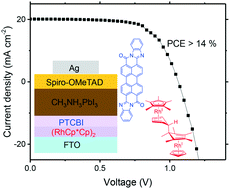Modification of the fluorinated tin oxide/electron-transporting material interface by a strong reductant and its effect on perovskite solar cell efficiency†
Abstract
To date, the most efficient hybrid metal halide peroskite solar cells employ TiO2 as electron-transporting material (ETM), making these devices unstable under UV light exposure. Replacing TiO2 with fullerene derivatives has been shown to result in improved electronic contact and increased device lifetime, making it of interest to assess whether similar improvements can be achieved by using other organic semiconductors as ETMs. In this work, we investigate perylene-3,4:9,10-tetracarboxylic bis(benzimidazole) as a vacuum-processable ETM, and we minimize electron-collection losses at the electron-selective contact by depositing pentamethylcyclopentadienyl cyclopentadienyl rhodium dimer, (RhCp*Cp)2, on fluorinated tin oxide. With (RhCp*Cp)2 as an interlayer, ohmic contacts can be formed, there is interfacial doping of the ETM, and stabilized power conversion efficiencies of up to 14.2% are obtained.

- This article is part of the themed collection: Perovskite Based Optoelectronics: Molecular Design Perspectives


 Please wait while we load your content...
Please wait while we load your content...